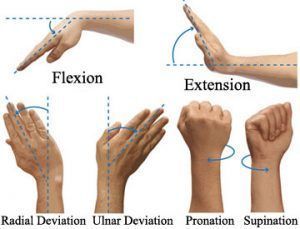As humans, we have spent a lifetime walking on our feet and ankles. As yogis and aerialists we now spend hours a day trying to balance and hold ourselves up on our hands and wrists. If you are finding that your wrists and/or forearms hurt when attempting various poses, or ache after a workout, you are not alone. Aside from shoulder injuries and torn hamstrings, wrist injuries are one of the most common aliments for yoga enthusiasts.
Personally, I have a genetic predisposition to Carpul Tunnel Syndrome. My mother, grandmother, and great aunt, have all had various surgeries to reduce pain and support their mobility and well being in their wrists. Hopefully, the strength and mobility I have attained from yoga and aerial training is working in my favour. I still get odd nerve pains and tenderness, but have found massage, nerve flossing, and rest (which even included learning how to use my computer mouse with my left hand!) are all effective in reducing pain and allowing me to continue training.
I have known many yogis who suffer from wrist ailments, such as ganglion cysts which all impact on their ability to practice. It is important to listen to your body and know when to stop or alter a move. There is no use pushing through and hoping the pain will go away. Many poses can be accomplished with the forearm on the ground, or by making a fist and resting on your knuckles, which allow the wrist to stay in a more neutral position.
Disclaimer – The following content is not intended to be a substitute for professional medical advice, diagnosis, or treatment. Always seek the advice of your physician or other qualified health professional with any questions you may have regarding a medical condition.

The wrist is a very complex set of joints, ligaments, and nerves that support the movement of the hand in four directions – flexing, extending, and deviating side to side. The wrist can also twist, what is known as pronation and supination. The structure of the wrist is made up for four main ligaments, three nerves, eight carpul bones, and five metacarpal bones. It goes without saying that a lot can go wrong if you fall on your wrist on put pressure on it in the wrong way!
It is important to warm up the wrists just like you warm up the rest of your body before getting on the mat. As well as wrist circles and stretches for the forearms and fingers, try this exercise:
Wrist lifts from all fours –
Moving your hands closer or further away from your body will alter the amount of pressure and change the required strength to execute the move. What you are aiming for is quality of movement over quantity. Try to make the movement as smooth as possible. You also don’t want to fatigue the wrists. This exercise involves lots of tiny muscles, ligaments, and tendons, that may not be used to working out. 5-10 repetitions as part of your warm up is more than enough.
If you have a theraband there is also a great wrist exercise you can do with a door handle or a railing. Standing next to the rigging point with the theraband at waist height, wrap the band around your palm and make a fist. Bring your elbow to you waist so your forearm is pointing out in front of you. Move away from the rigging point to increase the tension in the band. Fold your hand down (in flexion) with your hand in a fist and slowly release back to a neutral position. Repeat 5-10 times with both hands. The tension offered by the theraband will support muscle strength throughout the wrist joint.
Massage can be great for the wrists too, especially after a practice session. You can massage your own wrists with the opposite hand, or if you are lucky to have a friend to help you, this is a great partner exercise –
Have you partner interlock their fingers with yours as they are facing you. Let your hands and arms go limp, as your partner shakes your hands up down. They can alternate with large motions or short and fast ones. I find this exercise is great for releasing lactic acid after a workout.
In all yoga poses where you are placing pressure on the wrist, try to ensure that you are forming a straight line from the elbow to the wrist.
- Our grip strength comes from the shoulder blade (scapula) and not from the wrist. This results in activating all of the muscles of the core body instead of using only one specific group, that of the forearm.
- We prevent prolonged hyperextension of the wrist, which might even lead to a carpal tunnel syndrome.”
As yogis and fitness enthusiasts we all dream of being able to continue flying forever and ever. But to do this, we need to take care of ourselves. Listening to our bodies, stopping moves that cause pain, and developing good technique to reduce injury are essential for any dancer. Taking appropriate rest days to let our bodies heal will also ensure we can move with strong, healthy bodies right into our 80s!\
If you are interested in learning more about wrist care, or want advice for making adjustments to your own yoga practice, or at home workout, contact me for a Live Coaching Session!